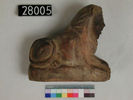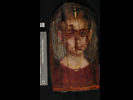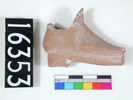| Homepage | Timeline | Maps | A-Z index | Learning |
Burial customs of the Roman Period in Egypt: before Christianity
Already by the end of the Ptolemaic Period burials were no longer being equipped with many types of object which had been made for the tomb for over one and a half thousand years, such as shabtis or canopic jars. Objects of daily use are not common in Egyptian burials of the Late and Ptolemaic Period, but became a popular burial good again under Roman rule: in particular, cosmetic objects are commonly found with women. Much research has been carried out on the development of single types of the objects placed in Roman tombs, such as the mummy portraits. By contrast the development of the arrangement of the burial goods as a whole has not yet been fully researched. Few cemeteries of the Roman Period are well recorded and published.
Egyptian style mummy masks were replaced by mummy masks in Greek or Roman style, or by painted mummy portraits in Greek perspective. Coffins lost their importance. They are often only simple boxes. Elaborate examples are still found in the first century or first half of the second century AD, and not later. The decorations in Egyptian style show that traditional Egyptian beliefs were still alive. However, there are only a few hieroglyphic inscriptions. In the early third century AD the last objects in Egyptian style were produced for burials. However, the dating of these items, such as the last mummy masks, is still under discussion.
Members of the elite were often buried under small chapels, found in almost all parts of Egypt. Multiple burials are common for all social levels. Mummification was very common, maybe even for not very wealthy people. Tomb stones with a Greek inscription or depictions in a mixed Greek-Egyptian style are common.
Some object types found in Roman tombs. Note that some of these types were never found together,
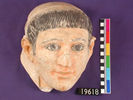 |
Plaster mummy masks in Greek/Roman style are common in elite burials. Especially expensive examples were gilded. |
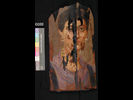 |
The painted mummy portraits are known from several cemeteries, but especially from the Fayum. |
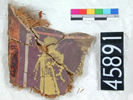 |
Decorated pieces placed on the mummy appear in many elite burials. Cartonnage is also the main material for more Egyptian style mask, which were produced till the beginning of the Third century AD. |
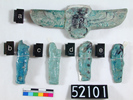 |
Faience amulets seems to disappear in the first century AD. In other materials, notably gilt wax, they seem to be attested for a longer period. |
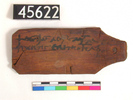 |
The Mummy often had a label with an inscription in Greek or demotic, giving the name and sometimes further information on the dead person. |
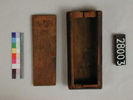 |
Objects of daily use were placed in many tombs. Women often had cosmetic items. |
Some tombs datable to the Roman Period
|
The burial of a girl or woman, with many 'sex-specific'
finds.
|
A multiple burial with five mummies, some adorned
with a painted portrait.
|
The burial of a rich woman.
|
The burial of a child.
|
Further reading:
